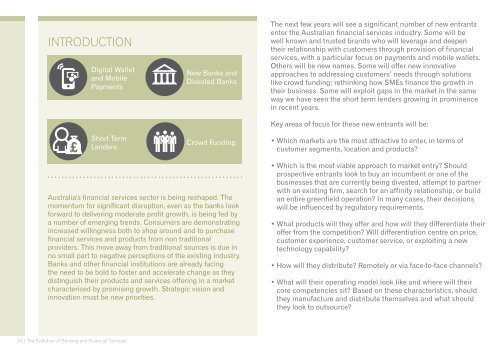EVOLUTION OF BANKING
Create successful ePaper yourself
Turn your PDF publications into a flip-book with our unique Google optimized e-Paper software.
INTRODUCTION<br />
Digital Wallet<br />
and Mobile<br />
Payments<br />
New Banks and<br />
Divested Banks<br />
The next few years will see a significant number of new entrants<br />
enter the Australian financial services industry. Some will be<br />
well known and trusted brands who will leverage and deepen<br />
their relationship with customers through provision of financial<br />
services, with a particular focus on payments and mobile wallets.<br />
Others will be new names. Some will offer new innovative<br />
approaches to addressing customers’ needs through solutions<br />
like crowd funding; rethinking how SMEs finance the growth in<br />
their business. Some will exploit gaps in the market in the same<br />
way we have seen the short term lenders growing in prominence<br />
in recent years.<br />
Key areas of focus for these new entrants will be:<br />
£<br />
Short Term<br />
Lenders<br />
Crowd Funding<br />
• Which markets are the most attractive to enter, in terms of<br />
customer segments, location and products?<br />
Australia’s financial services sector is being reshaped. The<br />
momentum for significant disruption, even as the banks look<br />
forward to delivering moderate profit growth, is being fed by<br />
a number of emerging trends. Consumers are demonstrating<br />
increased willingness both to shop around and to purchase<br />
financial services and products from non traditional<br />
providers. This move away from traditional sources is due in<br />
no small part to negative perceptions of the existing industry.<br />
Banks and other financial institutions are already facing<br />
the need to be bold to foster and accelerate change as they<br />
distinguish their products and services offering in a market<br />
characterised by promising growth. Strategic vision and<br />
innovation must be new priorities.<br />
• Which is the most viable approach to market entry? Should<br />
prospective entrants look to buy an incumbent or one of the<br />
businesses that are currently being divested, attempt to partner<br />
with an existing firm, search for an affinity relationship, or build<br />
an entire greenfield operation? In many cases, their decisions<br />
will be influenced by regulatory requirements.<br />
• What products will they offer and how will they differentiate their<br />
offer from the competition? Will differentiation centre on price,<br />
customer experience, customer service, or exploiting a new<br />
technology capability?<br />
• How will they distribute? Remotely or via face-to-face channels?<br />
• What will their operating model look like and where will their<br />
core competencies sit? Based on these characteristics, should<br />
they manufacture and distribute themselves and what should<br />
they look to outsource?<br />
24 | The Evolution of Banking and Financial Services


